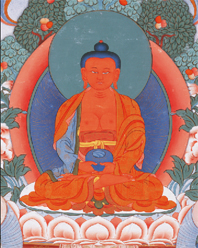Brief Sukhavati Aspiration: Difference between revisions
mNo edit summary |
mNo edit summary |
||
| Line 1: | Line 1: | ||
[[Image:Amitabha.jpg|frame| | [[Image:Amitabha.jpg|frame|[[Amitabha]] from a [[thangka]] in the personal collection of Sogyal Rinpoche]]EMAHO<br> | ||
NGO TSAR SANGYÉ NANGWA TAYÉ DANG<br> | NGO TSAR SANGYÉ NANGWA TAYÉ DANG<br> | ||
| Line 62: | Line 62: | ||
[[Category:Prayers and Practices]] | [[Category:Prayers and Practices]] | ||
[[Category: Aspiration Prayers]] | |||
[[Category:Tibetan Texts]] | [[Category:Tibetan Texts]] | ||
Revision as of 22:48, 3 September 2011

EMAHO
NGO TSAR SANGYÉ NANGWA TAYÉ DANG
Amitabha, magnificent Buddha of Boundless Light,
YÉ SU JOWO TUKJÉ CHENPO DANG
With the great compassionate lord Avalokiteshvara to his right,
YÖN DU SEMPA TU CHEN TOP NAM LA
And the mighty bodhisattva Vajrapani on his left,
SANGYÉ CHANG SEM PAKMÉ KHOR GYI KOR
Surrounded by an assembly of countless buddhas and bodhisattvas
DÉ KYI NGO TSAR PAK TU MÉPA YI
In the place of wonder and boundless joy and happiness—
DEWA CHEN SHYÉ JA WÉ SHYING KHAM DER
That is the heavenly realm of Sukhavati, the Blissful Paradise.
DAK NI DI NÉ TSÉ PÖ GYUR MA TAK
When the time comes for me to leave this present life,
KYEWA SHYEN GYI BAR MA CHÖ PA RU
May I go there directly, without any other birth upon the way,
DÉ RU KYÉ NÉ NANG TÉ SHYAL TONG SHOK
And being reborn there, may I see Amitabha face to face!
DÉ KÉ DAK GI MÖNLAM TABPA DI
May this, my fervent prayer of aspiration,
CHOK CHÜI SANGYÉ CHANG SEM TAMCHÉ KYI
Be blessed by all the buddhas and bodhisattvas of the ten directions
GEK MÉ DRUBPAR CHIN GYI LAP TU SOL
So that it is accomplished, without the slightest hindrance!
TEYATA PENTSIN DRIYA AWA BODHANAYÉ SOHA
When Tulku Mingyur Dorje was thirteen years old, on the 7th day of the month of Saga Dawa, Fire Bird year (1657), he had a vision of the deities of the mandala, and Buddha Amitabha spoke these words directly.
Tibetan text
| This section contains Tibetan script. Without proper Tibetan rendering support configured, you may see other symbols instead of Tibetan script. |
༈ སྨོན་ལམ་བསྡུས་པ་ནི།
ཨེ་མ་ཧོ༔ ངོ་མཚར་སངས་རྒྱས་སྣང་བ་མཐའ་ཡས་དང་༔
གཡས་སུ་ཇོ་བོ་ཐུགས་རྗེ་ཆེན་པོ་དང་༔
གཡོན་དུ་སེམས་དཔའ་མཐུ་ཆེན་ཐོབ་རྣམས་ལ༔
སངས་རྒྱས་བྱང་སེམས་དཔག་མེད་འཁོར་གྱིས་བསྐོར༔
བདེ་སྐྱིད་ངོ་མཚར་དཔག་ཏུ་མེད་པ་ཡི༔
བདེ་བ་ཅན་ཞེས་བྱ་བའི་ཞིང་ཁམས་དེར༔
བདག་ནི་འདི་ནས་ཚེ་འཕོས་གྱུར་མ་ཐག༔
སྐྱེ་བ་གཞན་གྱིས་བར་མ་ཆོད་པ་རུ༔
དེ་རུ་སྐྱེས་ནས་སྣང་མཐའི་ཞལ་མཐོང་ཤོག༔
དེ་སྐད་བདག་གིས་སྨོན་ལམ་བཏབ་པ་འདི༔
ཕྱོགས་བཅུའི་སངས་རྒྱས་བྱང་སེམས་ཐམས་ཅད་ཀྱིས༔
གེགས་མེད་འགྲུབ་པར་བྱིན་གྱིས་བརླབ་ཏུ་གསོལ༔
ཏདྱ་ཐཱ༔ པཉྩ་ནྡྲི་ཡ་ཨཱ་ཝ་བོ་དྷ་ནཱ་ཡེ་སྭཱ་ཧཱ༔
ཞེས་པ་འདི་ནི་སྤྲུལ་སྐུ་མི་འགྱུར་རྡོ་རྗེ་དགུང་ལོ་བཅུ་གསུམ་གསེར་འཕྱང་གི་ལོ་ས་ག་ཟླ་བའི་ཚེས་བདུན་ལ་གཙོ་འཁོར་རྣམས་ཀྱིས་ཞལ་གཟིགས་པའི་ཚེ་སངས་རྒྱས་སྣང་བ་མཐའ་ཡས་ཀྱིས་དངོས་སུ་གསུངས་པའོ།། །།
